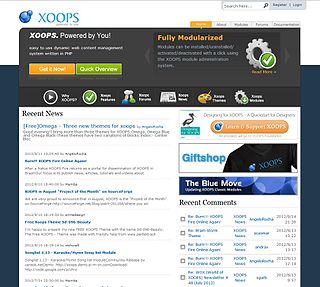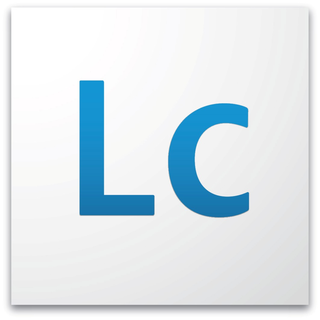
A database is an organized collection of data, generally stored and accessed electronically from a computer system. Where databases are more complex they are often developed using formal design and modeling techniques.

Wiki software is a collaborative software that runs a wiki, which allows users to create and collaboratively edit "pages" or entries via a web browser. A wiki system is usually a web application that runs on one or more web servers. The content, including all current and previous revisions, is usually stored in either a file system or a database. Wikis are a type of web content management system, and the most commonly supported off-the-shelf software that web hosting facilities offer. There are currently dozens of actively maintained wiki engines, in a variety of programming languages, including both open source and proprietary applications. These vary widely in their platform support, in their support for natural language characters and conventions, and in their assumptions about technical versus social control of editing.
A web portal is a specially designed website that brings information from diverse sources, like emails, online forums and search engines, together in a uniform way. Usually, each information source gets its dedicated area on the page for displaying information ; often, the user can configure which ones to display. Variants of portals include mashups and intranet "dashboards" for executives and managers. The extent to which content is displayed in a "uniform way" may depend on the intended user and the intended purpose, as well as the diversity of the content. Very often design emphasis is on a certain "metaphor" for configuring and customizing the presentation of the content and the chosen implementation framework or code libraries. In addition, the role of the user in an organization may determine which content can be added to the portal or deleted from the portal configuration.

XOOPS is a free open-source content management systems (CMS), written in PHP. It uses a modular architecture allowing users to customize, update and theme their websites. XOOPS is released under the terms of the GNU General Public License (GPL) and is free to use, modify and redistribute.
Enterprise content management (ECM) extends the concept of content management by adding a time line for each content item and possibly enforcing processes for the creation, approval and distribution of them. Systems that implement ECM generally provide a secure repository for managed items, be they analog or digital, that indexes them. They also include one or more methods for importing content to bring new items under management and several presentation methods to make items available for use.
DocuShare is a content management system developed by Xerox Corporation. DocuShare makes use of open standards and allows for managing content, integrating it with other business systems, and developing customized and packaged software applications.
A web content management system is a software content management system (CMS) specifically for web content. It provides website authoring, collaboration, and administration tools that help users with little knowledge of web programming languages or markup languages create and manage website content. A WCMS provides the foundation for collaboration, providing users the ability to manage documents and output for multiple author editing and participation. Most systems use a content repository or a database to store page content, metadata, and other information assets the system needs.
A video search engine is a web-based search engine which crawls the web for video content. Some video search engines parse externally hosted content while others allow content to be uploaded and hosted on their own servers. Some engines also allow users to search by video format type and by length of the clip. The video search results are usually accompanied by a thumbnail view of the video.

DSpace is an open source repository software package typically used for creating open access repositories for scholarly and/or published digital content. While DSpace shares some feature overlap with content management systems and document management systems, the DSpace repository software serves a specific need as a digital archives system, focused on the long-term storage, access and preservation of digital content.

Fedora is a digital asset management (DAM) architecture upon which institutional repositories, digital archives, and digital library systems might be built. Fedora is the underlying architecture for a digital repository, and is not a complete management, indexing, discovery, and delivery application. It is a modular architecture built on the principle that interoperability and extensibility are best achieved by the integration of data, interfaces, and mechanisms as clearly defined modules.

Adobe LiveCycle Enterprise Suite (ES4) is a service-oriented architecture Java EE server software product from Adobe Systems used to build applications that automate a broad range of business processes for enterprises and government agencies. LiveCycle ES4 is an enterprise document and form platform that allows capturing and processing information, delivering personalized communications, and protecting and tracking sensitive information. It is used for purposes such as account opening, services and benefits enrollment, correspondence management, request for proposal processes, and other manual based workflows. LiveCycle ES4 incorporates new features with a particular focus on mobile devices. LiveCycle applications also function in both online or offline environments. These capabilities are enabled through the use of Adobe Reader, HTML/PhoneGap and the Flash Player clients to reach desktop computers and mobile devices.
Enterprise search is the practice of making content from multiple enterprise-type sources, such as databases and intranets, searchable to a defined audience.
Documentum is an enterprise content management platform, now owned by OpenText, as well as the name of the software company that originally developed the technology. EMC acquired Documentum for $1.7 billion in December, 2003. The Documentum platform was part of EMC's Enterprise Content Division (ECD) business unit, one of EMC's four operating divisions.

Metadata is "data [information] that provides information about other data". Many distinct types of metadata exist, among these descriptive metadata, structural metadata, administrative metadata, reference metadata and statistical metadata.
Content Migration is the process of moving information stored on a Web content management system (CMS), Digital asset management (DAM), Document management system (DMS), or flat HTML based system to a new system. Flat HTML content can entail HTML files, Active Server Pages (ASP), JavaServer Pages (JSP), PHP, or content stored in some type of HTML/JavaScript based system and can be either static or dynamic content.
Discoverability is the degree to which of something, especially a piece of content or information, can be found in a search of a file, database, or other information system. Discoverability is a concern in library and information science, many aspects of digital media, software and web development, and in marketing, since something cannot be used if people cannot find it or do not understand what it can be used for. Metadata, or "information about information," such as a book's title, a product's description, or a website's keywords, affects how discoverable something is on a database or online. In the 2010s, adding metadata to a product that is available online can make it easier for end users to find the product. For example, if a song file is made available online, making the title, name of the band, genre, year of release, and other pertinent information available in connection with this song file will make it easier for users to find this song file. Organizing information by putting it into alphabetical order or including it in a search engine is an example of how to improve discoverability. Discoverability is related to, but different from, accessibility and usability, other qualities that affect the usefulness of a piece of information.
IBM WebSphere Service Registry and Repository (WSRR) is a service registry for use in a Service-oriented architecture.







